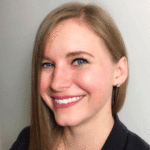Interactions Between Invading Tumor and Lung Cells Permit Metastatic Lung Colonization of Osteosarcoma
Interactions Between Invading Tumor and Lung Cells Permit Metastatic Lung Colonization of Osteosarcoma https://pediatricsnationwide.org/wp-content/themes/corpus/images/empty/thumbnail.jpg 150 150 Lauren Dembeck Lauren Dembeck https://pediatricsnationwide.org/wp-content/uploads/2021/03/Dembeck_headshot.gif- January 26, 2024
- Lauren Dembeck
Survival signals elicited by lung tissue interactions promote osteosarcoma metastasis and represent a promising target for clinical trials in both human and canine patients.
Osteosarcoma, the most common primary tumor of bone, occurs predominantly in children, teens and young adults. Patient survival largely depends upon the presence or absence of metastasis. Within five years of diagnosis, approximately 30% of patients with localized disease die, while over 80% of patients who develop metastasis die.
“Osteosarcoma has an unusual propensity for a single location of metastasis — to the lung. When lung metastasis occurs, it makes everything much more difficult; the tumors tend to not respond to systemic therapies and become harder to resect,” explained Ryan Roberts, MD, PhD, a principal investigator for the Center for Childhood Cancer Research at the Abigail Wexner Research Institute and physician for the Division of Hematology and Oncology at Nationwide Children’s Hospital. “While resection surgeries have greatly improved in recent years, systemic therapies haven’t seen much progress over the past 40 years.”
Although established metastatic lesions are aggressive, it is believed that the lung is a hostile environment for invading tumor cells, thus few will survive upon reaching the lung. Dr. Roberts and colleagues have now identified mechanisms that help those few surviving cancer cells to persist within lung tissues after dissemination. The findings were published in Cellular Oncology and offer insights into therapeutic strategies that could prevent and treat metastasis.
The collaborative effort was spearheaded by then-graduate student Camille McAloney of The Ohio State University College of Veterinary Medicine. Using single-cell RNA-sequencing (scRNAseq), the team evaluated gene expression changes in murine primary osteosarcoma tumor cells and metastasis-bearing lung cells at different time points during metastatic colonization.
The gene expression changes that they identified suggested activation of the mitogen-activated protein kinase (MAPK) pathway in both early and established metastatic tumors compared with primary tumor. MAPK activity has been implicated in pro-tumorigenic functions, including transcription and stabilization of anti-apoptotic proteins. Further analysis in cultures of patient-derived tumor cells confirmed that MAPK activity, and particularly ERK phosphorylation, increased with metastasis and increased further when tumor cells were grown in the presence of fibroblasts.
To understand what specific ligands from lung stromal cells, including fibroblasts, natural killer cells and macrophages, may drive the increased ERK activity in early metastatic cells, the researchers used NicheNet, a software that can identify the mediators of cell-cell interactions in scRNAseq data, to predict active ligand-target links between interacting cells. They found that several of the stromal cells express growth factors that signal through the MAPK/ERK pathway to increase the expression of MCL1, a pro-survival protein, within tumor cells.
“We always thought of structural cells of the lung as being mostly inert, but here, we discovered that these cells are actively engaging with the tumor cells, giving them a way to survive an environment that is very different from the one that they came from,” added Dr. Roberts, who is also a member of the Translational Therapeutics research program at the James Comprehensive Cancer Center at The Ohio State University.
This led the team to ask whether inhibiting MCL1 could prevent metastasis or disrupt established metastatic tumors. In murine models of osteosarcoma, they found that both early and established metastases are vulnerable to MCL1 inhibition — combining MCL1 inhibition with chemotherapy both prevented colonization and eliminated established metastases in vivo.
“We were able to cure mice that had established lung metastases. I don’t think I’ve ever seen that before,” said Dr. Roberts. “We’re now working to translate these findings into the clinic.”
The researchers are testing a number of additional models and will continue collaborating with veterinary colleagues who have developed systems for conducting clinical trials in dogs, which often develop highly metastatic osteosarcoma. Thus, the therapeutic testing strategy may prove to be useful not only for pet owners but could also provide valuable preclinical safety and efficacy data before moving to clinical trials for children, explained Dr. Roberts.
Reference:
McAloney CA, Makkawi R, Budhathoki Y, Cannon MV, Franz EM, Gross AC, Cam M, Vetter TA, Duhen R, Davies AE, Roberts RD. Host-derived growth factors drive ERK phosphorylation and MCL1 expression to promote osteosarcoma cell survival during metastatic lung colonization. Cell Oncol (Dordr). 2023 Sep 7. doi: 10.1007/s13402-023-00867-w. Epub ahead of print.
About the author
Lauren Dembeck, PhD, is a freelance science and medical writer based in New York City. She completed her BS in biology and BA in foreign languages at West Virginia University. Dr. Dembeck studied the genetic basis of natural variation in complex traits for her doctorate in genetics at North Carolina State University. She then conducted postdoctoral research on the formation and regulation of neuronal circuits at the Okinawa Institute of Science and Technology in Japan.
-
Lauren Dembeckhttps://pediatricsnationwide.org/author/lauren-dembeck/
-
Lauren Dembeckhttps://pediatricsnationwide.org/author/lauren-dembeck/
-
Lauren Dembeckhttps://pediatricsnationwide.org/author/lauren-dembeck/
-
Lauren Dembeckhttps://pediatricsnationwide.org/author/lauren-dembeck/January 29, 2019







